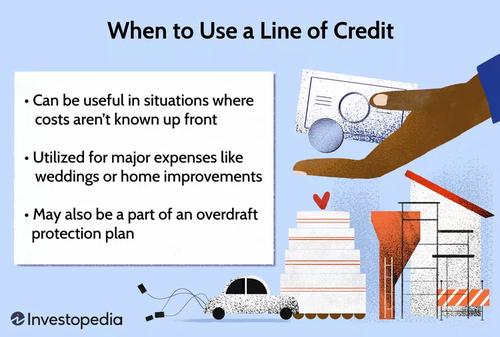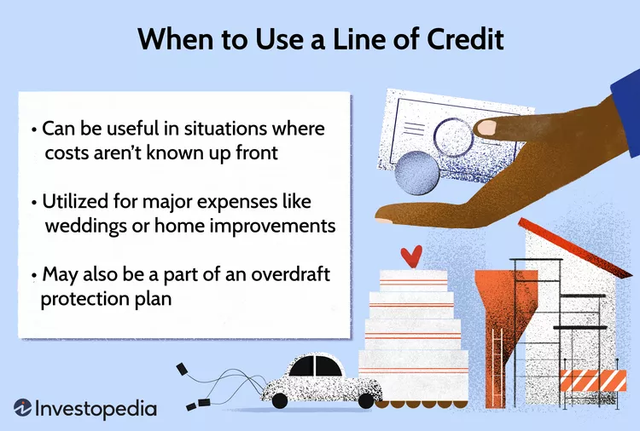
When you need money, you may consider getting a personal loan, which provides a lump-sum amount. However, if you don’t know exactly how much money you may need, you may want to consider a line of credit.
A line of credit is a revolving loan that allows you to access money as you need it up to a certain limit. You can borrow up to that limit again as the money is repaid. Learn more about what a line of credit is, about the different types, when to avoid them, and how to use them to your advantage.
KEY TAKEAWAYS
- A line of credit is a flexible loan from a financial institution that consists of a defined amount of money that you can access as needed.
- You can repay what you borrow from a line of credit immediately or over time in regular minimum payments.
- Interest is charged on a line of credit as soon as money is borrowed.
- Lines of credit can be used to cover unexpected expenses that do not fit your budget.
- Potential downsides include high interest rates, late payment fees, and the potential to spend more than you can afford to repay.

Investopedia / Michela Buttignol
What Is a Line of Credit?
A line of credit is a flexible loan from a bank or financial institution. Similar to a credit card with a set credit limit, a line of credit is a defined amount of money that you can access as needed and use as you wish. Then, you can repay what you used immediately or over time.
As with a loan, you will pay interest using a line of credit. Borrowers must be approved by the bank, which considers credit rating and/or your relationship with the bank, among other factors. Lines of credit tend to be lower-risk than using a credit card, but they are not as common.
A line of credit can be secured or unsecured. If you offer an asset you own as collateral for the line of credit, you’ll pay a lower rate than if you were to offer the lender nothing they can potentially take from you in the case of default.
Unlike with personal loans, the interest rate on a line of credit is generally variable, meaning it could change as broader interest rates change. This can make it difficult to predict what the money you borrow will end up costing you.
Important: Interest rates on lines of credit tend to be variable, though some banks offer fixed rates.
When a Line of Credit Is Useful
Lines of credit are not intended to be used to fund one-time purchases such as houses or cars, though they can be used to acquire items for which a bank might not normally underwrite a loan. Most commonly, individual lines of credit are intended for unexpected expenses or to finance projects that have unclear costs.
Pros and Cons of Lines of Credit
Pros:
- Access to instant, ongoing funds
- Potentially great way to finance projects that have unclear costs
- Similar flexibility to credit cards but with lower interest rates
- Can be secured or unsecured
Cons:
- Often harder to qualify for than personal loans
- Variable rates of interest make it harder to predict your costs
- Lines of credit can carry a number of fees and confuse borrowers
- For more competitive rates, need to offer collateral
Problems With Lines of Credit
Like other loan products, lines of credit have benefits and risks to consider. Firstly, if you have poor credit, you may not even get approved for this product. And, if you do, you’ll have to pay the money back and make sure you can afford to make those repayments.
Some banks will charge a maintenance fee (either monthly or annually), even if you don’t use the line of credit, and a transaction fee every time you draw money. And interest starts accumulating as soon as money is borrowed. Because lines of credit can be drawn on and repaid on an unscheduled basis, some borrowers may find the interest calculations for lines of credit more complicated. You could be surprised at what you end up paying in interest.
The cost of borrowing money can be expensive, particularly if you take out a personal line of credit that is unsecured. Offering lines of credit without collateral is riskier for lenders and that generally means higher interest rates and greater difficulty getting your request for credit accepted.
The alternative is also risky. Home equity lines of credit (HELOCs) use your home equity as collateral. This reduces borrowing costs but means if you default on payments the bank or financial insutition has the right to take possession of your home. In other words, you could end up homeless.
Tip: Lines of credit can be useful in situations where costs may not be known upfront. Personal lines of credit may also be part of an overdraft protection plan.
Comparing Lines of Credit to Other Types of Borrowing
Lines of credit have similarities and differences compared to other financing methods like credit cards, personal loans, and payday loans.
Credit Cards
Like credit cards, lines of credit have preset limits in that you are approved to borrow a certain amount. Also, like credit cards, policies for going over that limit vary with the lender. Also similar to a credit card, a line of credit is essentially preapproved, and the money can be accessed whenever the borrower wants for whatever use. Lastly, while a credit card and a line of credit may have annual fees, neither charges interest until there is an outstanding balance.
Fast Fact: Unlike credit cards, some lines of credit can be secured with real property, such as with home equity lines of credit (HELOCs).
Credit cards will always have minimum monthly payments, and companies will significantly increase the interest rate if those payments are not met. Lines of credit may or may not have similar immediate monthly repayment requirements.
Personal Loans
Like a traditional loan, a line of credit requires acceptable credit and repayment of the funds and charges interest. Also like a loan, using a line of credit responsibly can improve a borrower’s credit score. You can use funds from personal loans and lines of credit for any purpose you like.
There are also several differences between these products. For example, a loan is typically for a fixed amount for a fixed time with a prearranged repayment schedule. In contrast, a line of credit has more flexibility and usually has a variable rate of interest. When interest rates rise, your line of credit will cost more, whereas payments for a fixed loan remain the same.
Payday and Pawn Loans
There are some similarities between lines of credit and payday and pawn loans, including the fact that you can use the funds as you wish. The differences, however, are considerable:
- For anyone who can qualify for a line of credit, the cost of funds will be dramatically lower than for a payday or pawn loan.
- The credit evaluation process is easier with a payday or pawn loan (there may be no credit check at all), and you get your funds more quickly.
- A line of credit is generally much larger than a payday or pawn loan.
How Do I Qualify for a Line of Credit?
To qualify for a line of credit, you will have to meet the lender’s standards, which typically include proving your creditworthiness with a minimum credit score, sufficient income, and other factors.
What Are the Disadvantages of a Line of Credit?
With any loan product, you can run the risk of getting into more debt than you can manage. If you cannot pay off the credit that you use, then your credit score will decline. The lender may also go after your assets or, for example, garnish your wages to get its money back. If a line of credit has a variable interest rate, you also risk the interest rate rising, which would mean paying more in total interest.
How Do I Pay Back a Line of Credit?
You pay back a line of credit by making the minimum monthly payment to the lender. You will receive a monthly bill that includes your advances, interest, and fees, You may be required to pay off the entire balance each year.
Is It Good To Have a Line of Credit but Not Use It?
One of the benefits of getting a line of credit rather than a standard loan is flexibility. You don’t necessarily have to tap into the available credit and, if you do, you only pay interest on what you use. If you don’t end up using the line of credit, no interest will accrue. There could potentially be other costs, though. Some lenders apply maintenance fees simply for having an account. Others may also levy inactivity or cancellation fees. Check the paperwork and small print before signing on the dotted line.
The Bottom Line
Lines of credit, like any financial product, have advantages and disadvantages, depending on how you use them. On one hand, excessive borrowing against a line of credit can get you into financial trouble. On the other hand, lines of credit can be cost-effective solutions to fund unexpected or major expenses.
As is the case with any loan, shop around and pay careful attention to the terms—particularly the fees, interest rate, and repayment schedule.
Comments are closed.
